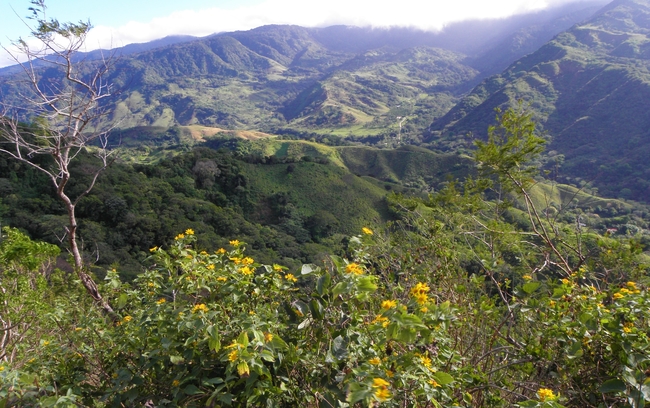

My wife Fyllis and I knew before traveling to Costa Rica that it has a well-deserved reputation for preserving its magnificent environment. We were aware of the diversity of landscapes and multiplicity of animal and bird life. But only after spending time in that virtual Garden of Eden did we fully appreciate so much variety compressed into an area smaller than the U.S. state of West Virginia.
The setting changes frequently in the compact Central American country. An uphill climb transports you from a jungle environment to an alpine woodland reminiscent of Switzerland. Stretches of forest and pockets of verdant wetlands lie in the shadow of volcanoes, several of which are active.
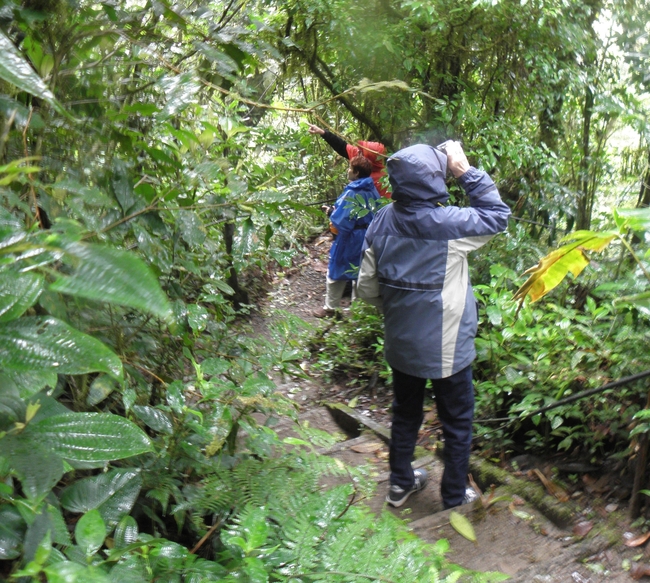
An astounding array of animal, bird and plant life is always close at hand. Because so much of the country is preserved in its natural state, human development is never far from Mother Nature,
Wishing to experience as much as possible of what Costa Rica has to offer, we chose to go there with a tour operator we have traveled with before. We chose Overseas Adventure Travel (OAT), the self-styled “Leader in small groups on the road less traveled.” The trip itinerary allowed us to pack as many experiences as possible into every hour.
Costa Rican Culture, Creatures and Much More
And packed with action every waking hour was. One typical day included a visit to an OAT-sponsored school where the children greeted our group with a charming folkloric presentation, a traditional lunch with a local family and a guided horseback ride through a dense forest. Another began with a hands-on tortilla-making lesson followed by opportunities to view giant crocodiles at close range, and ended with a visit to one of Costa Rica’s most beautiful beaches.
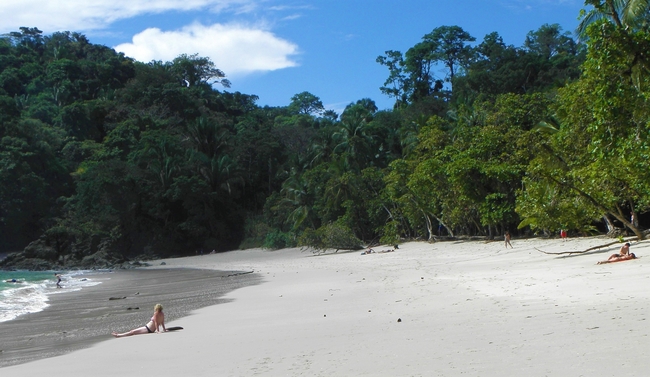
Much time was spent being introduced to the country’s major claims to tourism fame – animal watching and exploring vast stretches of unspoiled environment.
Costa Rica: An Environmental Success Story
While Costa Rica today is renowned for being at the forefront of efforts to protect and preserve nature, that wasn’t always so.
Several decades ago, this was one of the most deforested countries in the Western Hemisphere, suffering from major pollution problems. Large tracts of forest were being cleared, highlands were threatened by coffee growers and the Pacific lowlands faced devastation by cattle ranchers and farmers.
Reacting to those challenges, the government responded efficiently and effectively. It clamped down on the export of many species of trees and began to require permits for timbering. It established a commission to prescribe remedies for the country’s growing environmental challenges.
The results were dramatic and successful. Close to one-third of Costa Rica now is preserved in parks and wildlife refuges. Among many laws passed to protect the environment is one which requires people who cut down trees for certain uses to plant several more in their place.
One result of these efforts is that Costa Rica was named the “greenest” and “happiest” country in the world by the New Economics Foundation.That independent organization, headquartered in London, promotes innovative solutions to environmental, social and economic issues.
This emphasis on preservation is being used to market Costa Rica as the eco-friendly destination it is. For example, hundreds of hotels, tour companies and other travel vendors have received Certification for Sustainable Tourism, a much-sought-after honor which recognizes and rewards their commitment to that goal.
The results of these efforts are evident everywhere. We saw small plots of wooded land owned by low-income locals who in the past would have sold the trees to raise money. Now they receive a subsidy from the government to retain them in their natural state.
Exploring Costa Rica’s Biodiversity
In order to help tour members experience and fully appreciate the results of Costa Rica’s environmental efforts, our itinerary included a hike in Manuel Antonio National Park. We were surprised, and delighted, to learn that it is both one of the smallest preserves in Costa Rica and one of the most bio-diverse areas in the world. Its varied terrain includes a luxuriant rain forest, bird sanctuaries and four inviting beaches.
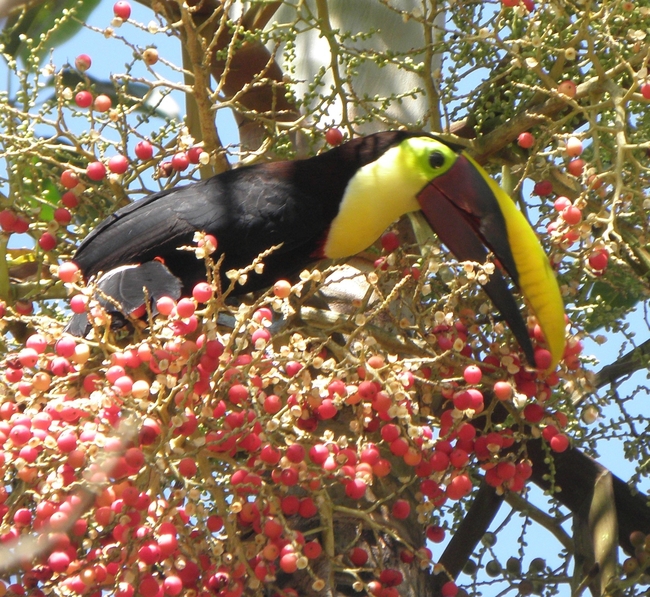
Enhancing the wonder is the opportunity to spot wildlife that thrives in this other-worldly environment. A sign at the entrance notes that 126 species of mammals and 448 types of birds hang out there.
Mammals include jaguars, pumas, ocelots, sloths and tapir. We heard the roar-like sounds of accurately named howler monkeys reverberating from treetops, but had trouble spotting those noisy but elusive critters. Fearsome-looking Iguanas rested on lower branches, resembling mini-dinosaurs basking in the sunlight that filtered through the upper canopy.
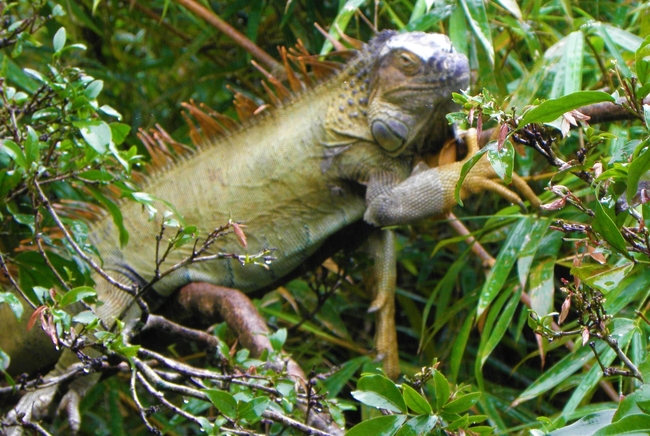
The incredibly rich diversity of wildlife is repeated in the Monteverde Cloud Forest. Over 1,000 species of butterflies dot its landscape with a myriad of colors. Some 850 types of birds have been spotted there, more than 600 of them permanent residents. Fortunately, we escaped encounters with the nearly 100 different kinds of mosquitoes that find Costa Rica’s damp environment to their liking.
When Christopher Columbus arrived in the area in 1502, he chose the name Costa Rica (“Rich Coast”” because he believed the land would yield a vast treasure of gold. But Spanish conquistadors who followed Chris soon realized they would not discover the mineral wealth they had hoped to find.
Visitors today discover wealth of a very different kind. No matter what the expectations, they – like Fyllis and me – are very likely to leave Costa Rica with memories of a magnificent natural setting, an extraordinary assortment of wildlife and people who value and protect the riches that Mother Nature has bestowed upon them.
If you go
While Fyllis and I often travel on our own, we agree that some destinations are best visited with a tour company. Group travel combines the convenience of having all logistics and transportation taken care of, receipt of a wealth of pre-trip information and the vast knowledge of seasoned guides. Overseas Adventure Travel boasts a 40-plus year history, offers trips to more than 75 countries from Albania to Zimbabwe, and limits land excursions to a maximum of 16 participants.
The company currently provides a choice of two itineraries to Costa Rica. For more information, log onto oattravel.com
Authors: Fyllis Hockman and Victor Block are a husband-wife team of experienced travel journalists who have gallivanted throughout the United States, and to nearly 80 countries around the world, and written about what they have seen, done and learned. Their articles have appeared in newspapers across the country and on websites across the Internet, and they each have won numerous writing awards. They love to explore new destinations and cultures and uncover off-the-beaten-path attractions. Read more of their work at The Rambling Writers
- Broward County, Florida: When the Winter Sun Hides Behind a Cloud - April 16, 2024
- Nature is Neat in Broward County, Florida - April 1, 2024
- Margaritaville: A Time-Honored Memorial to Jimmy Buffett - March 15, 2024
